
Google, after it rolled out several updates – from Panda to RankBrain AI- is very clear on its purpose to deliver results that are more focused on user’s intent. That being said, it is more important than ever to design your content strategy into a user-centered approach, rather than just mere keywords.
Creating user-centric content is the best way to get found on Google in today’s search engine arena. According to Confluent Forms, a user-centric content strategy is your way of looking at your site, your content, your audience and:
- defining your goals for you and your audience members,
- defining how and where you’re going to interact with them,
- defining the best ways for you to produce and share content that advances your goals.
But how do you make a content that is geared towards humans? Lucky for you, we have compiled in this post six actionable tips that will get you started in creating user-centric content today.
1. Start with Semantic Search
A user-centric content is a piece of material that actually full-fills the original intention of the searchers no matter what it is. In Semantic Search, search engines deliver the most accurate results based on what it thinks the user is looking for.
You have to understand how search engines discern context- much like the understanding the psychology of user’s intent. Optimizing your content for semantic search is the only way to stay relevant in the ever-evolving search engines like Google.
Here’s how to make your content copy work in semantic search:
- Create Context – Context makes your copy easier to be understood by semantic search-driven search engines
- Focus on Long-Tail Keywords – Many of the searches today are conducted using semantic keywords and phrases. You have to come up with different variations of your keyword to help you generate final stem of keywords that answer the searcher’s questions
- Link Out to Relevant Resources – Linking to relevant sites is a strong signal that tells your audience that your content is reliable and trustworthy.
- Write Using Your Audience’s Natural Language – Your content should match your audience’s natural language to make it easier to understand.
2. Define your core audience
It is important to determine the audience that you’re reaching out to even before you start the content creation process. You cannot simply shove your content in the vast world of the internet without having a solid and targeted audience that will read and appreciate your piece.
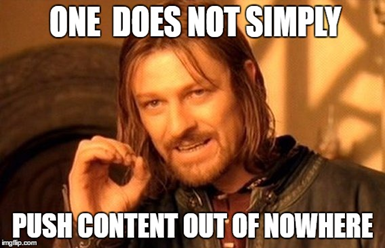
Some questions that will help you understand your core audience are:
- What is the demographics of your target audience? You have to identify the age, sex, marital status and other key demographic information of your audience to help you streamline data-gathering for the next questions.
- Where does your target audience usually hang out? Know what type of channel your target audience lurks in. They can be spending most of their time on blogging sites, or on various social media channels.
- What are their day-to-day concerns? Identify the main concerns of your target audience. Look at the big picture, and don’t limit this information to just the difficulties your business can help them solve.
- How can you help? Once you’ve identified their concerns, you can help them solve their problems by providing useful or entertaining information.
3. Understand Your Audience’s Pain Points
Your content should appeal to a specific group of people that is going through a specific pain point. Look at your most shared content and understand the reason behind its success. People are more likely to share contents that are useful and can actually fix their problems.
Here is how you identify your audience’s pain points:
- Identify Your Niche’s Most Popular Blogs – Start by conducting a quick Google search, using phrases that are closely related to your niche. Take a look at the search results and pick a blog at that top the search results.
- Find the Blog Posts That Get Shared the Most – Dig deeper into their blog posts and identify the most shared blog posts. You can do this using socialcount.co, BuzzSumo, or SEMRush.
- Find the Pages That Generate the Most Traffic – The traffic volume is a solid indicator of the types of problems your audience is thinking about and searching for. You can also do this using SEMRush
- Explore the Comment on These Popular Posts – Once you find a blog post with lots of comments, read through them and keep an eye for comments that hint your customer pain points- that is, comments where readers express their challenges, frustrations, worries, and problems.
4. Use the Entire Buying Cycle
There are 4 stages of the online buying process, namely: Awareness, Consideration, Intent, and Decision. Also, Rand Fishkin of Moz has identified 4 segments of user intent. Each segment presents an opportunity of how and what information should you include in your user-centric content.
- Navigational Searches – Performed with the intent of surfing directly to a specific website.
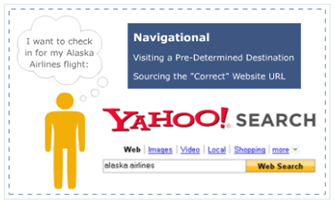
Image Source: Moz
- Informational Searches – Take in a huge range of queries from finding out the local weather to getting a map & directions.
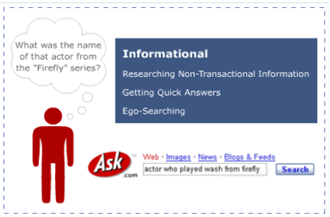
Image Source: Moz
- Commercial Investigation – User is starting to understand the topic and is on its way to discovering options for future transactions.
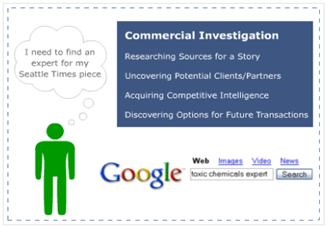
Image Source: Moz
- Transactional – Uncovering a potential supplier. Completing a task or making a purchase online.

Image Source: Moz
You can mold your user-centric content by aligning these segments onto the buying cycle stages to maximize its purpose to the unique needs of each user.
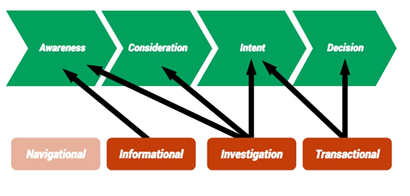
Image Source: White.Net
5. Answer Questions and Make It Interesting
Aside from answering questions, another important factor to make your content user-centric is on how you structure it. You have to be sincere when answering user’s questions, meaning not sounding too “salesy” or aggressive, among others. This because 74% of people get discouraged when content, ads, promotion, offers etc. are irrelevant to them.
To make your content more interesting, you have to:
- Tell a story – Our brain becomes more responsive when hearing a story, thus it can make your content a lot catchier.
- Write in First Person – Writing in the first person point of view makes your content more personal, giving your audience a relaxed perspective about your topic.
- Foreshadow – Foreshadowing is a literary device that gives “hint” at what’s coming ahead in your content. It increases the excitement and anticipation in a story in a way that it will make your audience think “What’s going to happen next?”
- Be Clear – Your content should be interestingly clear. It should convey your ideas using the right words in the right place. Don’t make it fancy.
6. Focus on the Benefits of Using the Product or Service, Not the Features
A lot of people are not attracted on the list of product or service features in a website because the words used to describe them aren’t understandable- especially if the term used is a made up specifically for the brand itself. To set it clear: Features are facts about your product; Benefits are what your product does for your readers. If you find it hard transforming your unique selling points into benefit statements, here’s how you can do it:
- Clearly Define Your Product/ Service Features – For example: Our Virtual Staffs are comprised of highly skilled college graduates with different technical expertise.
- Describe Why/How The Future Is a Benefit by Asking “So What?” – For example: Our Virtual Staffs can do your non-core operations effective and efficiently by following the latest industry standards.
- Make Statements on How is it Different Than Others – For example: We voluntarily support our staff in their desire for continuing education and self-improvement, while others either don’t do it or only once in a great while.
- Describe Why is it a Better Option – For example: Our Virtual Staffs are able to get the job done right the first time, thus saving you a lot of money.
- Pose a Closing Option – For example: Given a choice between in-house and virtual staff, who do you think are far more cost-effective in accomplishing your goals?
The reason for making your content user-centric is to offer the best user experience as possible to your audience. In this digital era where the attention span of people is getting shorter and shorter, giving them an immediate solution that is perfectly suited to their needs is the best way to stay afloat in this tightly competitive world of content marketing.
Jomer B. Gregorio is a well-rounded expert when it comes digital marketing. Jomer is also known as a semantic SEO evangelist and practitioner. Check out our Digital Marketing Services today and let us help you in achieving positive and profitable results for your business.
